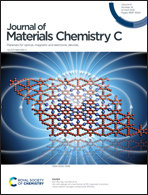Ultralong-lived room temperature phosphorescence from N and P codoped self-protective carbonized polymer dots for confidential information encryption and decryption†
Abstract
Room-temperature phosphorescent (RTP) carbon dots offer unique opportunities in information security applications, but the delay time of such materials reported thus far is typically shorter than 10 s and thus affects readout of the encoded information. Herein, a fast processable and one-step synthetic approach is developed for the preparation of N and P codoped carbonized polymer dots (NP-CPDs) exhibiting ultralong-lived RTP (URTP) responses. The URTP emission with the delay time exceeding 23 s (lifetime of ∼1.48 s) can be clearly identified with the naked eye. The presence of self-protective covalently crosslinked frameworks with codoped N and P atoms and the formation of interdot/intradot hydrogen-bonded skeletons are suggested to account for the observed URTP phenomena. The NP-CPDs exhibit excellent water solubility and color conservation during repeated liquid–solid transformations, thus allowing for a fast and large-scale ink-jet print of such nanodots to encode information. Consequently, the potential application of such NP-CPDs in anticounterfeiting and information encryption is demonstrated. This study provides a facile strategy to prepare URTP nanostructures for intriguing applications.



 Please wait while we load your content...
Please wait while we load your content...